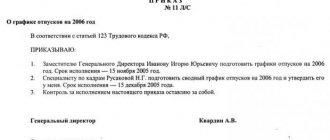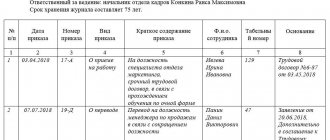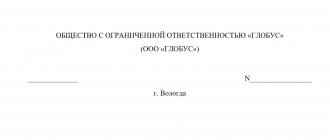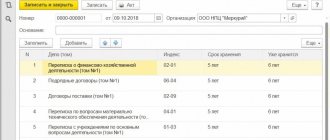Employee Relations
Properly organized document flow in an enterprise is the key to the success of its activities. Therefore, business papers should always be given due attention, which means they should be properly prepared and stored.
It is worth recalling that labor relations between employer and employees are always regulated by the Labor Code of the Russian Federation. It is on the basis of its articles that the enterprise must properly organize the procedure for dismissal, hiring and transfer of employees. All those papers that indicate the stages of workers’ labor activity are documents on personnel (personnel, personnel).
The purpose of these papers is to correctly formalize and consolidate the labor relationship between employees and the employer. It is worth noting that personnel documentation is one of the most important aspects of the activities of the personnel service at any enterprise. The correctness and timeliness of paperwork must be under the control of the manager.
Most of the documentation is mandatory and is provided for by the Labor Code of the Russian Federation, instructions on maintaining work books, Pension legislation and other regulations.
https://youtu.be/lLIyC9MUHZQ
Labor relations between an institution and an employee are regulated by the Labor Code of the Russian Federation. Based on the articles of the Code, the institution must establish a uniform procedure for processing the hiring, dismissal, and transfer of employees. The set of documents that record the stages of employees’ work activities is called personnel documentation. Such documents include:
1 Employment contracts concluded between the employer and the employee;
2 Orders on personnel (on hiring, dismissal, transfer of employees);
3 Work books;
4 Personal cards form T-2;
5 Personal matters;
6 Personal accounts for wages.
12.
Documents on personnel are the most important documents and require special care and accuracy when preparing, maintaining and ensuring safety over a long period of time.
When working with documents on personnel, it is necessary to take into account that the Law classifies personal data (information about facts, events and circumstances of work and personal life) of citizens as confidential information.
For the scheme of documents for admission, dismissal, transfer, see Appendix No. 13
Recruitment:
1 One of the main documents regulating the legal relationship between an employee and an institution is an employment contract.
2 After signing the contract, an order to hire the employee is issued. Based on the order, a personal T-2 card is issued and a personal file is opened. An entry is made in the work book
3 Copies of the order are sent to the personal file and accounting department. Where they assign a personnel number and open a personal salary account.
Dismissal:
1 The application is written two weeks before the expected dismissal
2 An order for dismissal of personnel is issued
3 In accordance with the order, an entry is made in the work book and in the personal card T-2
4 Copies of the order are sent to the personal file and accounting department, where a full settlement with the employee is made.
When translating:
1 An order is issued for personnel on transfer to another position
2 Based on the order, an entry is made in the labor record indicating the new position and in the personal card.
3 Copies of the order are sent to the personal file and accounting department.
1.4.1. EMPLOYMENT CONTRACTS
EMPLOYMENT AGREEMENT is a document recording the agreement of the parties to establish labor relations and regulating them. The parties to the employment contract are the institution and the employee ( see Appendix No. 14)
In accordance with Article 67 of the Labor Code of the Russian Federation, an employment contract must be concluded in writing. The written form increases the guarantees of the parties in the implementation of the agreements reached on the most important working conditions.
When concluding a contract, it is recommended to indicate the following basic conditions:
1 Place of work (name of the enterprise where the employee is hired, his address)
2 Specific work in accordance with the qualifications for a certain profession or position that the employee must perform.
3 Start date of work and end date if a fixed-term contract ends
4 Remuneration
5 Responsibilities of the institution to ensure labor protection.
The agreement may also contain additional conditions specifying the obligations of the parties. These include a probationary period, combination of professions; training; additional holidays, etc.
The contractual form of employment, establishment and remuneration applies to the following categories of workers:
13.
1 For permanent employees;
2 On temporary;
3 Working at their main place of work;
4 Part-time workers.
The employment contract defines the employee’s responsibilities in accordance with the profession or position for which he is hired, or a reference is made to the corresponding job description developed and approved by the management of the institution.
The content of the employment contract is determined on the basis of Art. 57 Labor Code of the Russian Federation.
According to Art. 58 of the Labor Code of the Russian Federation, an employment contract can be concluded for an indefinite period, for a certain, but not more than 5 years, for the duration of certain work.
When concluding an employment contract, the following conditions cannot be established by agreement of the parties:
1 Grounds for dismissal of an employee;
2 Disciplinary sanctions not provided for by law
3 Introduction of full financial liability for employees, except in cases provided for by the Labor Code of the Russian Federation.
The contract is drawn up in two copies, signed by both parties, certified by a seal. One copy is kept in the institution, the other with the employee.
The employment contract is included in the personal files of employees. In this case, their storage period corresponds to the storage period of personal files. If personal files are not opened, the contracts are formed into a separate file alphabetically by the surnames of the employees. Employment contracts are stored for 75 years – “B” (75 years minus the employee’s age).
Types of documents for personnel
Personnel documents can be divided into the following types:
- Papers related to the staffing of the enterprise.
- Documents confirming the promotion of employees.
- Papers confirming the fulfillment of labor discipline.
- Documents related to termination of employment relationships.
As we can see, personnel documents include many papers that regulate the relationship between employers and employees. All of them regulate certain issues related to the personnel of the enterprise.
Primary documents on personnel are divided into two types:
- For personnel records.
- For recording working hours and calculations related to wages.
Personnel documents include: orders, employment contracts, diplomas, certificates, work books, personal files, cards, employee certification certificates, personal powers of attorney.
Lists of workers and party members
List of participants at the 1927 Congress of Party Members, including detailed personal information.
Documents on personnel The list of participants in the 1927 Congress of Party Members contains the following personal information.
- FULL NAME,
- Floor,
- year of birth,
- social status,
- Nationality,
- Union experience,
- Party experience
- Active work experience
- The scale of union work,
- Once again elected to this committee,
- Where and in what capacity did he work before this congress?
- Where and in what capacity does he currently work?
Document storage
In recent years, unfortunately, there has been a tendency for insufficient attention to the safety of business papers. Based on the results of inspections of the state archival service, conclusions were drawn that the storage of personnel documents under normal conditions is observed in only 20% of inspected enterprises.
Although every enterprise must comply with the rules established by law. The correct attitude towards business papers is directly related to the need for assistance from organizations with pension insurance authorities and other government agencies. Violations of document management can lead to undesirable consequences and also threaten a fine.
Documents on personnel (types of papers are given in the article) indicate the length of service of people, and are also the basis for assigning pensions and other payments to citizens. If an employer makes any mistakes that understate an employee’s income, a person can challenge this fact in court.
In addition, it is worth understanding that storing documents on personnel is necessary, since only on their basis can historical information that took place be restored. It is not for nothing that the longest retention periods are established by law for personnel records.
Needless to say, documents should not be lost; moreover, they must be kept in proper conditions. The head and head of the personnel department of any organization are obliged to provide all the conditions necessary for current and archival storage.
The main requirements for the content of papers include:
- Availability of a separate room for current storage.
- Boxes or cabinets with papers must be locked with a key.
- Access to documents should be limited.
- You need to allocate a separate room for the archive and control access to it.
Shelf life
The storage periods for personnel documents are the longest compared to other business documents. Documents with long shelf life include:
- All administrative papers - instructions, orders, resolutions.
- Lists of employees.
- Employee registration cards.
- Personal things.
- Personal accounts of employees.
- Work orders and report cards.
- Employment contracts and agreements.
- Minutes of meetings.
- Lists of people who are retiring on preferential pensions.
- Books for recording the hiring and dismissal of employees.
We have not provided the entire list of those papers that have been stored for 75 years. The following documents are exceptions:
- Acts on industrial accidents – 45 years.
- Tariff sheet – 25 years.
- Minutes of meetings of the commission on the payment of bonuses for length of service - 15 years.
During the established time, the enterprise must ensure the safety of papers in the manner prescribed by law.
Prompt storage of personal documents
Proper storage of personnel documents is one of the main responsibilities of personnel services employees. The information contained in them is classified as personal and is not subject to disclosure. In addition, such documents must be stored and processed in accordance with special conditions.
View gallery
Before signing an employment contract, the future employee must be given written permission to process personal data. A copy of this document is filed in a personal file or in a separate folder.
All documents relating to personal data must be stored separately from general papers. Access to them is allowed only to HR specialists and the first manager of the organization. It is strictly prohibited to disclose personal data of employees to third parties and organizations. The exception is made by judicial and prosecutorial authorities that have submitted an official documented request.
To store personal documents, a separate nomenclature of files is created. Folders and boxes with documents are placed in locked cabinets. It is advisable to isolate them from direct sunlight and elevated temperatures. For a large number of documents, it is advisable to allocate a special room.
Personal files, questionnaires and personal cards are kept in operational storage as long as the organization cooperates with a specific employee. After dismissal, they are sent to archival storage.
Personnel orders are stored for a year after their issue. Job descriptions and other instructions are valid indefinitely until they are cancelled. The staffing table, as well as the vacation schedule, are published annually and stored in the personnel department or in the accounting department for another year after completion of the action.
Preparation of documents
The archive of documents on personnel at the enterprise must be located in a separate room, which is not accessible to unauthorized persons. Cases that are fully prepared and properly prepared are transferred to it. It is worth noting that the preparation of papers begins at the stage of their creation.
The HR department is responsible for the correct execution of personnel documents. For ease of use of the entire mass of papers, they are arranged by personnel officers as follows:
- Cases are drawn up for each type of document: for orders, personal files, protocols, etc. Headings are indicated on the folders, reflecting the nomenclature.
- All cases are assigned accounting numbers and an inventory is included.
- Confidential, secure, ongoing storage is provided: in a safe or locked cabinet.
- All leaves of the case are filed and numbered. And the location of the firmware is sealed with the seal of the enterprise and certified by the signatures of the responsible persons.
- In every case there must certainly be internal inventories.
- All details are indicated on the covers of finished documents: shelf life, names, dates.
Questionnaires of responsible employees
Questionnaires of responsible party workers were created for each employee during the Soviet period. It was slightly different from the questionnaire of a candidate for a party member in the early period (read more).
Questionnaire of a responsible employee from the personal file of Konstantin Nikolaevich Donov, 1920. Personnel documents
What information can you learn from this questionnaire?
- Full Name.
- Age.
- Main profession.
- Family composition.
- Nationality.
- Time of joining the Russian Communist Party (Bolsheviks)
Formation of a personal file
The personal file contains all those documents that contain information about the employee of the enterprise and his work activities. In principle, personal files should be opened for all employees of the organization. But, as a rule, currently HR officers prepare them only for leading specialists and managers. The organization has the right to independently decide what kind of papers to register for employees. Therefore, the composition of personal file documents may differ at different enterprises. But in general it should include the following papers:
- Inventory of case documents.
- Resume and autobiography.
- Questionnaire.
- Copies of documents confirming education.
- Copies of specifications.
- Copies of the order confirming the position.
- Employment contract.
- All kinds of information.
- Copies of orders of appointment, dismissal and transfer.
The internal inventory should contain information about the serial numbers of each document in the file. Such a document is signed by the person who compiled it.
Inside the file there must be a questionnaire that contains a lot of information regarding the biography, education, and marital status of the employee. In order to fill it out correctly, workers, as a rule, use a work book, military ID and passport, and diploma.
Personnel records
Documents for personnel records are maintained by the personnel officer. On the basis of primary securities, operational accounting of changes and movements in the number of employees of the enterprise is carried out. Accounting documents include: orders, cards, staffing tables, pay slips and many other documents.
When hired, each employee is assigned a personnel number, which is subsequently listed in all personnel records and payroll records. Even if a person is moved to a new position or dismissed, his personnel number remains with him and is not assigned to another person.
Orders for personnel
Orders of documents on personnel are one of the most important papers in personnel matters. They are grouped into separate cases and have their own numbering. Inside, the folder is organized chronologically.
Some orders are created in a unified form, filling in only the necessary columns in the future. All the rest are drawn up as needed, but all documents must meet certain requirements.
The organization of personnel documents, including orders, is carried out on the basis of their storage periods. It is logical to file them into cases that have the same deadlines. For example, orders for admission and dismissal must be retained for 75 years, which means they must be kept separate from annual documents regulating leave and stored for only five years.
If the enterprise is large and the document flow is fairly decent, then different types of papers can be filed in a separate file (for example, vacation orders - one folder, business trip orders - another). This will make working with documents much easier. In addition, each individual case is entered into the organization’s nomenclature. If the order contains an appendix, it is also filed. But as for the grounds for orders - reports, statements, acts - they are stored separately.
As practice shows, orders and the reasons for them are kept together in current office work, but in preparation for archival storage they begin to be reorganized, placed in different folders. Statements, for example, are kept for up to 75 years, but they are part of a personal file.
All other grounds have a shelf life of up to five years, so they are formed into a separate file.
Group of organizational orders: where to get a sample?
This set of personnel orders accompanies each employee from the moment of hiring until separation from the company, including all the nuances of internal movements.
Hiring and dismissal orders are the most common in this group. It is customary to draw them up using unified forms, although the use of order forms independently developed by the company is not prohibited by law.
Study samples of the organizational group of orders for personnel using the materials on our website:
- ;
- “Unified form No. T-8 - form and sample filling.”
Orders on the movement of employees are a set of different types of orders from the head of the company on various personnel changes or linear movements of members of the workforce.
Among them are the following types of orders:
- about the parallel movement of employees, for example from one position to a similar one in another department;
- about a dynamic rise (“career step”) or demotion;
- on temporary relocation: to the place of an absent employee, due to medical indications for a certain time, etc.
The material will help you get to know this subgroup of orders for the movement of employees.
Storing orders
To determine the storage period for orders, you need to use a standard list of documents. It is periodically reviewed and updated. At the moment, the list compiled in 2010 is current. According to it, as before, the grounds for orders must be stored for about five years, and most of the orders themselves are preserved for up to 75 years (on the performance of duties, business trips, changes in names, vacations and certifications).
In addition, you can navigate the storage periods using departmental lists compiled for organizations in certain areas of activity. The rules provide for an examination of the value of securities.
Long-term storage papers must be transferred to the personnel document archive. An inventory is drawn up on them, after which they are transferred for long-term storage.
Cases whose retention period has passed may be destroyed.
Archival storage of personnel documents
After the expiration of the operational storage period, personnel data is sent to the archive of personnel documents. This can be a division of the organization or a third-party, most often government, organization.
The list of documents subject to long-term archival storage is as follows:
- personal files, questionnaires and personal cards of resigned employees;
- unclaimed work books and inserts;
- orders and instructions for personnel with expired shelf life;
- journals for recording the movement of personnel documents;
- staffing schedule;
- vacation schedules;
- other documents the need for storage of which is provided for by law or the commission.
Documents for the archive are prepared by an employee of the HR department or a secretary. Cases and other papers can be stored for a long time both in the organization itself and under an agreement in a specialized institution.
Documents in the folder for long-term storage are organized by date, starting from the earliest. You should carefully monitor the physical safety of the paper and, if necessary, make and certify a copy. All sheets of the case are numbered and stitched, after which an inventory is drawn up.
Folders with documents should be placed in strict order. In the room itself, it is necessary to maintain optimal temperature and low humidity, and also prevent direct sunlight. Shelves should be regularly cleaned of dust, and rooms with documents should be treated from rodents and other pests.
How to destroy documents?
The enterprise's archival papers can be destroyed (if the storage period has expired) independently, or you can seek help from special organizations that deal with this issue. No matter how you organize the process, a destruction act must be drawn up.
You can burn the papers yourself if there is a safe place for this, or you can destroy them using a special apparatus. In such cases, the act is written in any form. But large volumes of cases are easier to hand over for disposal. But even in this case, all actions must be accompanied by paperwork. The acceptance certificate must record the number of cases and their weight. It is better if an employee of the organization is personally present during the destruction of papers to maintain confidentiality.
State Archives
In each region of the Russian Federation there is a state archive of documents on personnel. The main task of its activity is to ensure reliable storage of papers for the personnel of all enterprises. In addition, the archive responds to requests from enterprises and citizens regarding issues related to personnel records. This area of his activity is very necessary and relevant, since when an organization is closed, people simply have nowhere to turn to get the necessary information.
It is for this reason that archives are faced with the task of preserving all papers. Currently, not only private, but also budgetary organizations are very often liquidated and closed. In this case, they must transfer documents on personnel for storage in the state archive. It must contain the following papers for 75 years: orders, pay slips, documents on relocation and dismissal, personal files, etc.
It is worth noting that cases must be prepared before transfer in accordance with all the rules. Municipal archives provide their services subject to prior approval for the delivery of documents.
Preparing papers for transfer includes the correct execution of all cases, an expert assessment of the papers, as well as drawing up inventories.
Do I need to pay money for storage? State and budgetary enterprises do not pay for archive services. Liquidated enterprises of non-state ownership transfer correctly completed cases only if there is an agreement.
Cases are transferred subject to approval and agreement with the archive's expert review commission. Reception and transfer of papers is carried out by employees of the institution in the presence of the liquidated organization. This process is quite lengthy and painstaking, since the condition of the documents is checked by visual inspection. At the end, a corresponding act is drawn up.
What is a “personal document”, “document of personal origin” and “personnel documents”
State standard of the Republic of Belarus STB 2059-2013 “Office management and archiving. Terms and Definitions" (hereinafter - STB 2059-2013) contains a number of complex terms, an integral part of which is the word “personal”: “personal document”, “document of personal origin”, “personnel documents”. Despite the external similarity of the names of these terms, they have different meanings.
A personal document is an official document identifying a person and (or) his rights, obligations, official or public position, which may contain other biographical information.
This definition contains two main characteristics of a personal document. First of all, a personal document is an official document. Like any official document, a personal document must be created by an organization or official and have identification details, which initially gives it legal force1. The second important characteristic of a personal document is that it is issued to an individual and contains biographical information (certifies the person’s identity, his rights, obligations, official or social position, etc.).
The type of personal documents is quite diverse. These include a passport, military ID, documents on education and training (certificates, diplomas, certificates, etc.), service and personal identification cards, certificates (of birth, marriage and divorce, right to benefits, etc.), work records of employees , copyright certificates and patents for inventions, etc.
It is necessary to distinguish between the concepts of “personal document” and “document of personal origin”.
A document of personal origin is a document created by a person outside the scope of his official activities or the performance of public duties.
From this definition it follows that documents of personal origin do not include official documents. Documentation of personal origin includes, for example, personal correspondence, personal photo albums, personal diaries, manuscripts of memoirs, manuscripts of literary works, scientific works created outside the scope of official activity, etc.
It should be noted that in the course of the life and activities of an individual, both documents created by him outside the scope of his official activities or the performance of public duties (documents of personal origin) and official documents issued to this person by organizations or officials for the purpose of identification identity and (or) confirmation of biographical information (personal documents). In everyday vocabulary, such a set of documents saved by an individual is often called a “personal archive,” which is incorrect from the point of view of professional terminology in the field of archiving and record keeping. The set of documents formed in the course of the life and activities of an individual is called a “documentary fund”; the corresponding definition of the term is available in STB 2059-2013 and the Rules for the operation of archives of state bodies and other organizations2. Since documentary funds are also formed in the course of the activities of organizations, it is advisable to use the concept of “personal documentary fund” (“personal fund”) to denote the totality of documents formed in the activities of an individual and owned by him by right of ownership. The corresponding term and its definition are absent in STB 2059-2013, which in some cases leads to the substitution of concepts3.
Thus, a personal documentary fund may include both personal documents and documents of personal origin. In the case of transferring these documents or part of them for storage to an archive (for example, to a state archive) with a corresponding transfer of ownership of the documents, the totality of documents accepted for storage in the archive receives the name “fund of personal origin” (in contrast to archival funds accepted for storage organizations). We also note that the personal origin fund will be able to include documents generated not only in the activities of one individual, but also his family and clan.
When analyzing the term “document of personal origin” and its definition, attention is drawn to the note contained in STB 2059-2013, according to which it is unacceptable to use the term “personal document” to refer to it. This prohibition in the standard is indicated by the words “NDP.” With this, STB 2059-2013 emphasizes the difference between the two terms and warns against their possible confusion.
However, this clarification in STB 2059-2013 seems unsuccessful. The standard defines both terms, which in itself highlights their different meanings. In addition, the introduction to STB 2059-2013 states that the abbreviation “NDP.” Synonyms that are unacceptable for use are indicated and given in parentheses. Since the terms “personal document” and “document of personal origin” have independent meanings that are different from each other, they cannot be synonyms (synonyms are words that sound different, but are the same or similar in meaning). In this case, we can rather talk not about synonymy, but about homonymy of two concepts (homonyms are words that have different meanings, but are the same in sound and spelling).
On this basis, it appears that the corresponding note to the term “document of personal origin” is redundant, incorrect and should be excluded from the standard.
STB 2059-2013 contains another term that combines the words “document” and “personal”: - documents on personnel - documents created upon hiring, transfer (relocation), dismissal of an employee, on the provision of leave, business trip, promotion , payment of wages, assignment of qualifications, category, title, other documents that can be used to confirm the period of work and (or) study, position (profession), as well as for other purposes related to ensuring the rights and legitimate interests of citizens.
This definition corresponds exactly to the definition contained in Art. 2 of the Law of the Republic of Belarus dated November 25, 2011 No. 323-Z “On archiving and record keeping in the Republic of Belarus.”
When analyzing the term “personnel documents”, it is advisable to pay attention to the following aspects.
Firstly, the definition of this term does not contain an exhaustive list of situations in which personnel documents are created. As follows from the definition, personnel documents include any document that can be used for purposes related to ensuring the rights and legitimate interests of citizens. Traditionally, this category includes documents used within the framework of state social insurance and social security systems.
Secondly, personnel documents are not only documents reflecting the labor relationship between employer and employee. According to the definition, personnel documents also include documents confirming the period of study (orders on enrollment in educational institutions, completion of studies, etc.). In this context, it is logical to include documents confirming the period of military service in the category of documents on personnel.
Thirdly, documents on personnel include not only documents created in the process of emergence, change or termination of labor relations, which are formed primarily in the activities of the organization’s personnel service. Personnel documents include documents on the payment of wages created in accounting (personal accounts, pay slips for calculating wages to employees, etc.). According to clause 165 of the Archive Rules, the summary inventory of personnel cases compiled in the organization’s archive includes documents on accidents, industrial accidents, occupational diseases, documents on certification of workplaces for working conditions and confirming the employment of workers in work with hazardous and (or) dangerous working conditions, etc. All these documents are also personnel documents.
The type of personnel documents is unusually diverse. These include statements, representations, memos, notifications, orders (instructions) on hiring, transfer to another job, dismissal, transfer to a contract form of employment, extension of employment agreements (contracts), conclusion of new employment agreements (contracts), on granting vacations, assigning ranks, classes, qualification categories, titles, awards, bonuses, temporary substitution, providing financial assistance, establishing allowances, additional payments, changing last name, first name, patronymic; employment agreements (contracts); documents of individual (personalized) registration of insured persons, etc.
Some personal documents, for example, work books, may also be classified as personnel documents.
Documents on personnel are an important part of the National Archival Fund of the Republic of Belarus. The need for their creation and storage in accordance with established requirements is enshrined in the Labor Code of the Republic of Belarus, the Law of the Republic of Belarus “On Archiving and Office Work in the Republic of Belarus, etc.
Sometimes the concept of “documents on personnel” is considered in a broad sense, and they include such types of documents as staffing, structure and staffing levels, etc. However, in the practice of office work and archival affairs, these documents are not included in the category “documents on personnel” included. For example, files with staffing tables, when transferred to the archive, are included not in the inventory of personnel files, but in the inventory of permanent storage files.
1 See Rybakov, A. Terminology in the field of office work and archiving: the concepts of “original document”, “original official document”, “original document”, “official document”. A. Rybakov // Archives and records management. - 2020. - No. 4. - P. 67-71; Rybakov, A. Terminology in the field of office work and archiving: the concept of “legal force of a document.” Legally significant details. A. Rybakov // Archives and records management. - 2016. - No. 6. - P. 58-65.
2 Approved by Resolution of the Ministry of Justice of the Republic of Belarus dated May 24, 2012 No. 143 (hereinafter referred to as the Rules for the Operation of Archives).
3 The concept of “personal fund” in STB 2059-2013 is used only as a synonym, unacceptable to designate the term “archival fund of personal origin,” which in this context seems fair.










